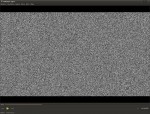 In a re-iteration of my previous experiment with making noise, I’ve now generated 12 seconds of Full HD noise for your viewing pleasure. Note that the audio is quite loud (or at least appears as such), so adjust your system volume accordingly.
In a re-iteration of my previous experiment with making noise, I’ve now generated 12 seconds of Full HD noise for your viewing pleasure. Note that the audio is quite loud (or at least appears as such), so adjust your system volume accordingly.
Again I used ImageMagick to generate the frames and Audacity for the soundtrack, but instead of ppmtompeg I used ffmpeg for combining the pictures into a video, for better compression offered by modern codecs.
First I cast this imagemagick spell:
$ time for i in `seq -f %04.0f 1 300`; do convert -size 1920x1080 \
xc: +noise Random -blur 1x1 -fx intensity -normalize -depth 8 ${i}.png; done
Completing this step took about 20 minutes in my current setup (an Athlon II X2 250). (Note that for just 300 frames there one excess 0 worth of padding in the seq parameter, because I initially did a longer sequence of lower res frames. Four or more are needed if you go beyond 1000 frames.)
Next I put the images together using ffmpeg. I compressed the video with x264:
$ ffmpeg -y -i %04d.png -vcodec libx264 -b 1800k -r 30 test.mp4
I then generated 12 seconds of white noise in Audacity, and exported it into a WAV file, which I then compressed using faac:
$ faac -q 300 -o noise12.aac noise12.wav
Finally I muxed the two together, again using ffmpeg:
$ ffmpeg -i test.mp4 -vcodec copy -i noise12.aac -acodec copy hdnoise.mp4


